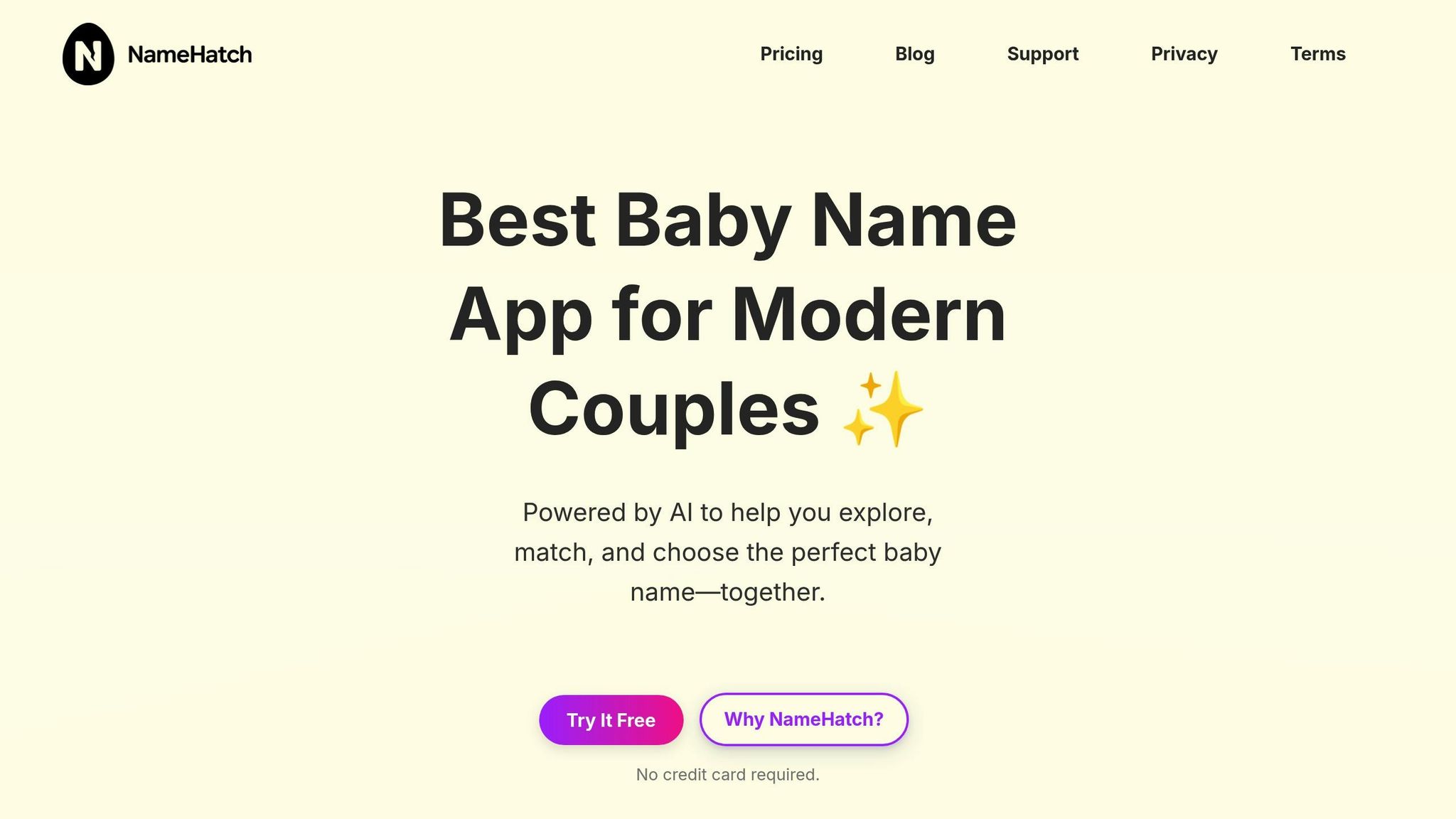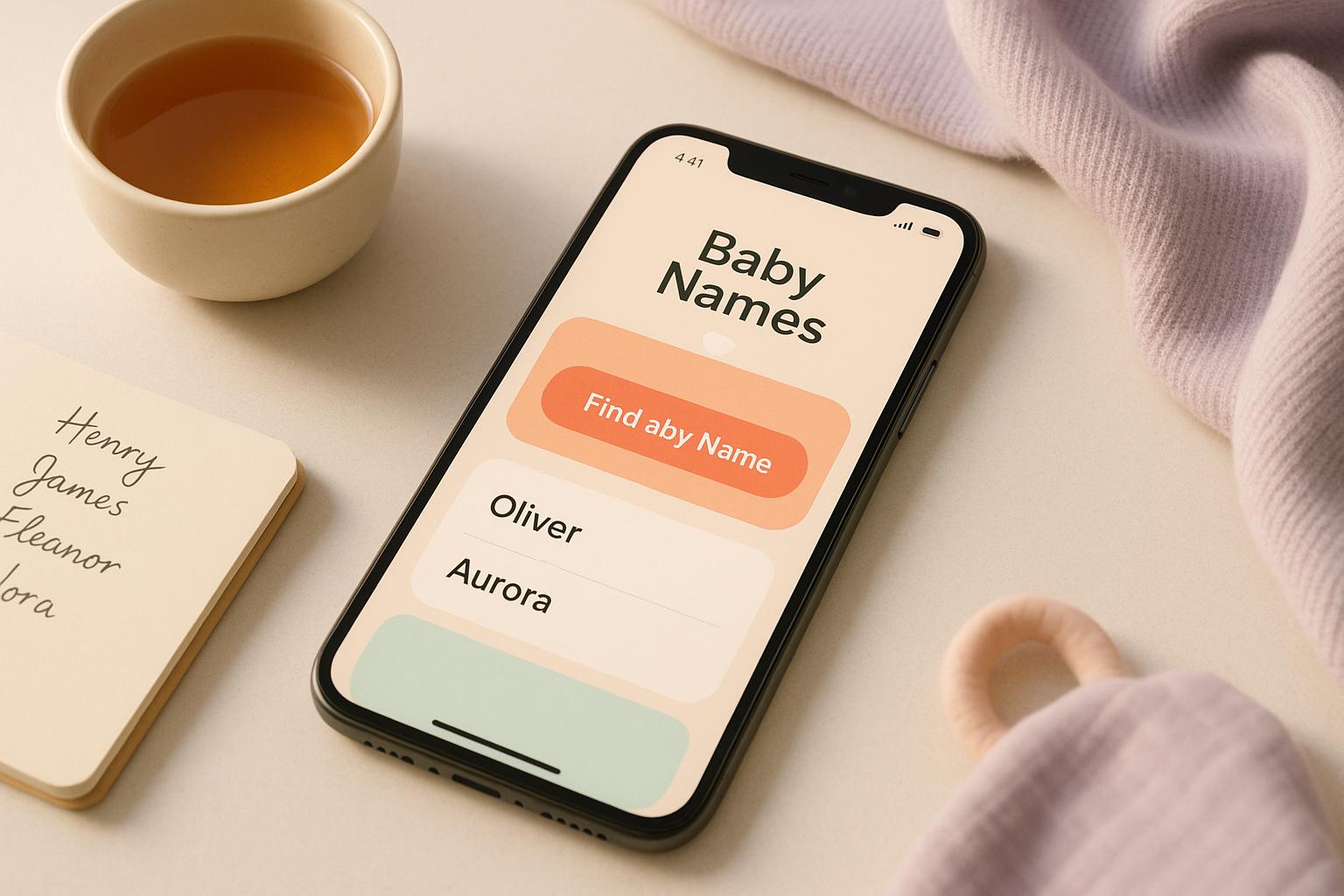Choosing a baby name together can be tough, but it’s also a chance to strengthen your partnership. Here’s how to make the process smoother:
- Start with clear criteria: Agree on what you both want in a name (e.g., length, style, cultural significance) and set deal-breakers early.
- Understand each other’s preferences: Discuss why certain names resonate with each of you, and look for patterns in your shared likes.
- Use tools like NameHatch: Apps can help you filter names, match preferences, and keep track of mutual favorites.
- Set boundaries with family: Respect traditions but prioritize what feels right for your family.
- Compromise creatively: Consider middle names, variations, or alternative spellings to meet in the middle.
- Test your top picks: Say them aloud, imagine them in different life stages, and reflect before finalizing.
How To Choose The Perfect Baby Name | Channel Mum

Common Problems When Couples Choose Baby Names
Choosing a baby name often uncovers deeper layers of a couple's values, experiences, and expectations. These discussions go beyond mere preferences - they touch on the core of what each person brings to the relationship.
Different Style Preferences
Partners often have contrasting tastes when it comes to names. One might lean toward timeless classics like Elizabeth or William, while the other prefers modern picks like Aria or Kai. Disagreements can also stem from differing views on popularity or cultural significance - one person might appreciate names that blend in, while the other seeks something more distinctive. These preferences are deeply personal, shaped by individual histories, artistic leanings, and family traditions.
As baby naming consultant Sherri Suzanne puts it:
"Names are like art and not like science".
This subjective nature makes finding common ground tricky. But understanding why a name resonates with each partner can pave the way to compromise. For instance, a love for traditional names might reflect a desire to honor family heritage, while a preference for modern names could represent a wish to break away and create something new.
External factors, like family and heritage, often add another layer to the naming process.
Family and Heritage Expectations
Family dynamics can complicate the search for the perfect name. Grandparents might push for a cherished family name, or cultural traditions might dictate specific naming patterns. As Colleen Slagen advises:
"Don't use a family name if you don't love it!".
Setting boundaries is essential in these situations. Emma Giordano, LMHC, explains:
"Boundaries are not about telling people what they can and can't do in your relationship. Instead, it's about what you will do if another person crosses the boundaries you have expressed to them."
When family expectations feel overwhelming, mental health counselor Peta-Gaye Sandiford suggests focusing on the larger picture - your role as loving parents. She emphasizes that a child’s identity is shaped by much more than their name.
Personal History with Names
Names carry emotional weight, and personal associations can spark conflict. For example, a name one partner loves might dredge up negative memories for the other. Clinical social worker Lizzette Potthoff explains:
"For a lot of people, the name is tied up in their own identity. When their partner rejects it, it feels like a personal rejection".
To ease these tensions, it helps to remember that these reactions are rooted in personal experiences, not a rejection of your ideas. Exploring positive associations with a name can sometimes soften objections, but this approach takes patience and understanding.
Potthoff advises couples to reframe their perspective, viewing the naming process as a shared challenge rather than a battleground. This mindset shift can transform disagreements into opportunities for collaboration.
Setting Clear Name Selection Criteria
Before diving into endless name options, many couples find it helpful to set some ground rules. These guidelines act as a compass, keeping the search focused on names that genuinely work for your family while steering clear of common disagreements.
Baby name expert Laura Wattenberg captures the spirit of this process perfectly:
"Names should be your chance to just sit back and dream."
But even dreaming needs a little structure. By setting clear parameters from the start, you can turn what might feel like an overwhelming task into a more enjoyable and purposeful journey. These criteria also help you make the most of NameHatch's features to refine your search.
Listing Requirements and Restrictions
Start by having an open conversation about what you're both looking for in a name. Jot down the qualities you want - maybe it’s a name that carries a meaningful history, reflects your heritage, or simply feels strong and confident when spoken.
Just as important is identifying your deal-breakers. Are there names tied to unpleasant memories? Names that are frequently mispronounced or misspelled? Practical considerations, like avoiding sounds that might be tricky for a parent with a speech impediment, should also come into play. Religious beliefs or family traditions may further shape your choices.
Be as specific as possible. For example, instead of saying you want a "unique" name, clarify with something like "not in the top 100." This level of detail helps avoid confusion or disagreements later on.
Setting Search Parameters
Once you've nailed down your criteria, use them to create clear boundaries that make the search process smoother. These filters can quickly weed out names that don’t fit your family’s needs.
Name length is one factor to think about. A long first name combined with a lengthy last name might feel unwieldy, while an extremely short name could seem incomplete. Decide what feels right for your family’s preferences.
Don’t forget to consider initials. Double-check how potential names pair with your last name to avoid awkward acronyms or unintended abbreviations. For instance, even a beautiful name might lose its charm if the initials spell something undesirable.
Family naming traditions are another layer to explore. In some families, it’s customary to honor grandparents or stick to specific naming patterns. Talk openly about these traditions and decide which ones you want to follow, adapt, or set aside.
Comparing Partner Preferences
One of the best ways to streamline the process is to create a system that shows where you and your partner align - and where you don’t. This approach highlights shared preferences and helps identify areas that may need compromise.
Start by each writing down 10–15 names you love. Then, rate each name as "love", "like", "neutral", or "reject." The names you both rate highly become your shared favorites list - a great starting point for finding the perfect name. Names with mixed ratings might warrant further discussion, while those with strong negative reactions from either partner can usually be ruled out.
Look for patterns in the names you both like. Maybe you’re drawn to similar sounds, origins, or styles. Use these trends to expand your list with options that could appeal to both of you. When disagreements arise, focus on understanding why certain names resonate with your partner instead of just defending your own picks. This collaborative approach often leads to creative solutions that reflect both of your preferences.
Once you’ve built your shared favorites list, you can tap into NameHatch to explore, refine, and narrow down your final choices.
Using NameHatch for Team Name Selection

Once you’ve nailed down your criteria and shared preferences, NameHatch turns the often tricky process of choosing a name into something enjoyable for both partners. By building on your established criteria, the app streamlines the naming journey, helping couples discover names that check all the right boxes.
Swipe Through Names Together
NameHatch uses a swipe-based system that feels familiar and easy to use. Each partner swipes independently - right for names they like and left for those they don’t. This approach lets you express your preferences privately, avoiding any awkward moments that can come from rejecting a name out loud.
The simplicity of this method makes decision-making quicker and less stressful. You don’t have to overanalyze every name - just go with your gut. Over time, this intuitive process reveals patterns in what appeals to both of you, helping you move closer to finding the perfect match.
Filter Names by Your Criteria
The app offers a range of filters to narrow down options based on your preferences. These include basic filters like Classic, Modern, Soft, and Strong, as well as premium filters for more specific themes such as Nature-Inspired, Global, Mythical, and Unique. You can also choose to filter by gender or keep the options open if you’re looking for a surprise.
- The Classic filter provides timeless, enduring names with historical appeal.
- The Modern filter focuses on names that feel fresh and current.
- Premium filters allow you to explore more tailored collections, perfect for those seeking names with specific themes or inspirations.
Get Instant Match Alerts
One of NameHatch’s standout features is its match alert system. When both partners like the same name, the app notifies you instantly. No more second-guessing or awkward conversations about whether your partner feels the same way about a name you love.
"When you both 'like' the same name, you'll get a match alert. All of these mutually agreeable names then populate a list all of their own and you can narrow things down together, free from the worry of suggesting a name that will get you that look. You know the one." - Apple's Editorial Team
These alerts make the process feel collaborative and exciting, turning what could be a stressful task into a fun shared experience. Plus, the automatic matching ensures that both partners have equal input, creating a balanced list of shared favorites to work from.
Save and Review Your Favorites
Once match alerts are triggered, NameHatch organizes those names into a dedicated favorites list, making it easy to keep track of your progress. As you sift through thousands of names, this feature ensures you don’t lose sight of the ones that stood out to both of you.
The favorites list becomes a handy starting point for deeper discussions. Instead of trying to remember names you liked weeks ago, you’ll have a curated list ready for review. This organization helps you spot patterns in your shared preferences and focus on names with lasting appeal.
The app also lets you save individual favorites, even if they’re not mutual matches. These can serve as conversation starters or help you refine what you’re looking for in a name.
This feature ensures you can track changes in your preferences over time. Names that once seemed perfect might lose their charm, while others may grow on you, helping you zero in on the ones that feel right for both partners.
sbb-itb-f13f980
Resolving Disagreements and Making Decisions
Even with NameHatch's thoughtful matching system and careful planning, you might still find yourselves clashing over certain names. That’s perfectly normal - picking a name is a deeply personal process, often tied to family traditions, personal values, and individual tastes. The key is to navigate these differences constructively while keeping your shared goal in focus: finding the perfect name for your child.
Once you’ve outlined your selection criteria and identified favorites using NameHatch, it’s time to tackle any remaining disagreements head-on.
Using Veto Rights and Rankings
A fair veto system can help balance decision-making between partners. By allowing each person to reject a set number of names without needing to justify their choice, you ensure that both voices are heard. This method acknowledges gut reactions and strong preferences while preventing one partner from dominating the process.
"Give each other veto power, for example, can help build a sense of ownership in the process, even if there is some initial disappointment".
To make this work, set clear rules from the start. For instance, you might agree that each partner gets three vetoes or that vetoes should only apply to names with specific reasons behind them.
When exercising veto power, it’s essential to listen actively and respond with simple affirmations like “I understand” or “I hear you” to maintain mutual respect.
After vetoes have been used, rank the remaining names together. Each partner can create a list of their top five picks, and then you can compare them side by side. Look for overlaps or names that hold similar positions on both lists. This structured approach can highlight natural alignments and pinpoint areas where compromise might be needed.
Focusing on Shared Favorites
Your NameHatch favorites list can be a lifesaver when disagreements arise. These are names that both of you liked enough to swipe right on, making them a great starting point for finding common ground.
Sometimes, a name that initially felt perfect might lose its charm upon closer inspection, while others may grow on you over time. Pay attention to patterns in your shared preferences - do you both lean toward shorter names, specific sounds, or particular origins? These patterns can guide your discussions.
If your mutual list feels too short, revisit names that sparked mild interest earlier. They might prove to be a good middle ground.
Finding Middle Ground Solutions
When agreeing on a first name feels impossible, creative compromises can offer a way forward. Middle names, for instance, provide an opportunity to honor a name one partner loves without making it the primary choice. This way, both preferences can be part of your child’s identity.
"When disagreements arise over baby names, focus more on understanding your partner's perspective than pushing your own. People are more willing to compromise when they feel heard".
Take time to explore why certain names resonate with each of you. Understanding the emotional connection behind a choice can make it easier to find alternatives that capture the same essence.
You can also consider variations or alternative spellings. For example, if you like “Catherine” but your partner prefers something more modern, you might explore “Kate” or “Cate.” Even subtle differences, like “Sara” versus “Sarah,” can help bridge gaps between traditional and contemporary tastes.
"Approach the situation as partners trying to solve a problem, rather than adversaries blaming each other".
Focus on finding a solution that works for your family, rather than trying to “win” the argument. Once you’ve explored compromises like middle names or variations, you can move on to evaluating your final options.
Weighing Final Options
When you’ve narrowed your list to a few strong contenders, take a closer look at each name to clarify your decision. Consider how each name sounds with your last name, potential nicknames, and whether it flows naturally in everyday conversations.
A practical way to test your choices is by using them in real-life scenarios. Write the names down, say them out loud, or imagine introducing your child with each name. This hands-on approach can reveal which name feels most natural and fitting.
If you’re still torn between two names, leaving the decision to chance - like flipping a coin - can sometimes clarify your true feelings.
"If you're ultimately disappointed with the name fate hands you, take it as a sign that your heart really was set on the other option. That might just be the final push you need to make a choice".
This process isn’t just about picking a name - it’s about working together as a team to make a meaningful decision for your family.
Making Your Final Name Choice
Now that you’ve worked through disagreements and narrowed down your favorites, it’s time to test and confirm your final choice. This is the moment to carefully evaluate your top contenders and ensure they’re the perfect fit.
Testing Your Top Names
A name might look great on paper, but how does it hold up in everyday life? The best way to decide is by putting your top picks through some real-world tests.
Say it out loud. Speak the names in different scenarios. Does the name roll off the tongue naturally? Try introducing yourself as if you were your child - does it feel comfortable and easy to say?
Consider potential nicknames. Names often evolve into shorter versions. For example, "Elizabeth" might become "Liz", "Beth", or "Ellie". Think about whether these nicknames align with your personal style and preferences.
Picture the name at every stage of life. Imagine your child as a playful toddler, a teenager walking across a graduation stage, and a professional adult. Some names feel adorable for a baby but may not age as well as your child grows.
These practical steps are a great way to complement the collaborative work you’ve done using NameHatch.
Allowing Time for Reflection
Before you make your final decision, give yourself a few days to live with the name in your daily life. Use this time to reflect on how the name feels and how it resonates with you both.
Pay attention to your emotions during this period. Are you growing more excited about the name, or do you find yourself second-guessing? Sometimes, a name that seemed ideal at first might lose its appeal after some thought.
"If you're feeling overwhelmed by options or second-guessing your top picks, these tips for choosing the perfect baby name can help guide you to a decision that feels just right."
– Catherine Reed, Tech-Savvy Writer
You might also consider seeking feedback from one trusted friend. Keep it simple - asking too many people can lead to conflicting opinions, which may only add confusion. If you find yourself doubting your choice, revisit the reasons why you loved the name in the first place. Think back to the excitement you both felt when it first stood out to you in NameHatch and how it made it through your entire decision-making process.
For added peace of mind, you might want to keep your decision private until after your baby is born. This can help you avoid unsolicited opinions from family and friends that might make you second-guess a name you truly love.
Marking This Milestone
Choosing your baby’s name is a meaningful milestone in your journey as parents. Take a moment to celebrate this achievement together - it’s a testament to your teamwork and shared vision.
Save your final choice in NameHatch and cherish this step as part of your parenting adventure. It’s a moment worth remembering!
Conclusion: Working Together to Name Your Baby
Deciding on your baby's name together is more than just picking a word; it's your first big parenting decision. Along the way, you’re learning essential skills like how to listen, compromise, and work as a team - skills that will serve you well in the years ahead.
This process not only strengthens your connection as partners but also highlights a common journey many parents share. And here’s some reassurance: a survey found that 91% of parents would choose the same name again if given the chance. Thoughtful collaboration often leads to a name you’ll both cherish.
"Approach the situation as partners trying to solve a problem, rather than adversaries blaming each other."
– Lizzette Potthoff, Clinical Social Worker
The communication and teamwork you’ve honed during this process will come in handy for future parenting decisions - whether it’s picking schools, setting rules, or navigating bedtime battles. Each choice will require blending your unique perspectives into a shared vision.
Tools like NameHatch make this journey smoother by offering features like name matching, filtering, and collaborative options. Instead of feeling stuck or overwhelmed, you can turn this decision into a fun, shared experience. Swiping through names together, setting criteria, and celebrating your matches lays the groundwork for effective co-parenting.
A name is more than just a label - it’s a reflection of your values, heritage, and dreams. By working together to find one you both love, you’re showing your commitment to honoring each other’s perspectives while building something meaningful for your family. This choice is a beautiful symbol of your shared journey into parenthood.
No matter how long it took to decide, the name you’ve chosen represents your unity and love. It’s a warm welcome to your child, marking the beginning of a life filled with shared care and connection.
FAQs
What can we do if one partner feels strongly about a specific baby name, but the other disagrees?
Disagreements over baby names can be tough, especially when one partner feels deeply connected to a particular name. The first step? Have an open and respectful conversation. Ask why the name holds such significance for them. Understanding the emotional story behind it can foster empathy and set the stage for finding middle ground.
Still can’t agree? Try creating a list of names you both like and explore new ideas together. Tools like NameHatch can help by offering personalized suggestions based on your preferences, making the process a bit easier. The ultimate goal is to pick a name that feels meaningful to both of you, so keep the lines of communication open and focus on working as a team.
How can both partners stay equally involved in choosing a baby name?
Choosing a baby name together can be a special journey when both partners feel equally involved. A great way to start is by having each of you jot down a list of your favorite names. Once you’ve got your lists, sit down together to compare and discuss. Focus on finding names that resonate with both of you by crossing off those one of you strongly dislikes and highlighting the ones you both like.
If narrowing it down feels tricky, try adding a bit of fun to the process. You could draw names from a hat or take turns ranking your top picks. It’s also worth having open conversations about what matters most to you in a name - whether it’s the style, meaning, or a personal connection. This way, you ensure both voices are part of the decision and can settle on a name that feels meaningful to you both.
How can we honor family traditions while choosing a baby name we both love?
Finding the perfect baby name that honors family traditions while reflecting your personal touch might seem tricky, but it’s definitely doable. Start by discussing any meaningful naming customs in your family - whether it’s passing down a relative’s name or following specific rituals. From there, think about how you can weave these traditions into your choice. For instance, you could use a traditional name as a middle name or opt for a modern twist on a family name.
The key here is open communication. Have honest conversations with your partner and family about what’s most important to everyone. If certain traditions hold deep meaning for your loved ones, consider involving them in the process. Share family stories, brainstorm ideas together, and find ways to blend heritage with creativity. This way, you can honor the past while creating something uniquely yours.



